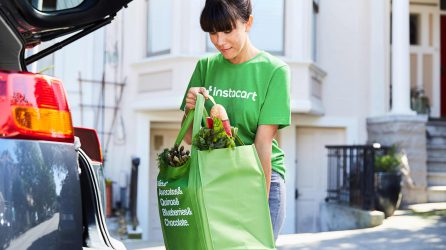These Ecommerce Growth Forecasts Will Change The Way CPGs Act

Presented by:
Josi Mathar — 2021
It is a truth universally acknowledged, that an industry in possession of good fortune, must be in want of continued growth.
The future for CPGs looks bright, if approached with the necessary focus. After a year tainted by disruption, eMarketer has revised its global ecommerce forecasts predicting retail ecommerce sales worldwide to rise to $4.921 trillion in 2021, climbing a further 16.8% from last year.
As mind-blowing these figures are, it’s key to keep calm and strategize on. How can future-focused CPGs retain their leadership position in their category during times of continued ecommerce growth? How can they keep ahead in light of rapidly adapting shopper habits, retailer model evolutions and a constant stream of challenger brands looking to gain visibility and win share? And what are the trends and capabilities frontline managers need to embrace at speed?
Read on as we summarize eMarketer’s latest global, US and China forecasts and what CPGs consequently should do to defend their category leadership position.
Global Ecommerce Forecast
eMarketer estimates that total retail sales worldwide dropped by 2.8% in 2020. But as everyone knows, retail ecommerce boomed as shoppers flocked the internet to stock up on everything from working from home essentials to their weekly online grocery shop. The latter in particular brought great challenges for CPGs and hyper growth for those brands that adapted quickly.
After the 2020 dip eMarketer expects retail ecommerce sales worldwide to climb to $4.921 trillion, a further 16.8% from last year.
What’s interesting is that countries previously lagging behind in online shopping have caught on and are expected to see further growth namely “India, Brazil, Russia, and Argentina are all projected to post at least 26% growth in retail ecommerce sales this year”, according to eMarketer’s team.
China Ecommerce Forecast
It’s no surprise that the global ecommerce mammoth China expanded it’s ecommerce market by 20.0% last year. But eMarketer is quick to point out that it’s retail ecommerce sales growth didn’t boom as much as originally anticipated. While this may be true, ecommerce is still forecasted to grow 18.5% making it the eighth fastest rate in the world.
Another noteworthy market-observation by eMarkter is around the ways in which digital buyers and sellers are connecting through social commerce and livestreaming in particular. To give readers a sense of scale eMarketer explains “if China’s ecommerce livestreamers were their own country, they would be the third largest retail ecommerce market in the world this year ($299.66 billion in sales).”
While markets all over the world adopt the social commerce and live streaming model, in China social commerce figures are already 10 times higher than in the US, namely $351.65 billion. China’s ecommerce livestreaming grew by 160% in 2020 and is expected to grow by another 85% in 2021.
US Ecommerce Forecast
eMarketer is confident about consumers’ pent-up demand for shopping to result in retail sales growth for both brick-and-mortar (B & M) as well as ecommerce now that the economy starts to reopen.
In fact, it projected total retail sales to grow 2.8% year over year (YoY) but revised that forecast to a 10.5% decline to then see 2020 sales grow by 3.4% as retailers managed to shift their operations to ecommerce.
Looking at the split between B & M and ecommerce eMarketer projects US consumers will spend $933.30 billion on ecommerce in 2021 signifying a YoY increase of 17.9% and equaling 15.3% of total retail sales. B & M retail spending will see the strongest growth rate since 2011 at 6.3% equalling $5.149 trillion spent in store.
The key trend however is how ecommerce continues to grow and with it the manifestation of newly-adopted buying behavior. eMarketer forecasts US ecommerce sales to reach around 23.6% of total retail sales by 2025 versus 11% in 2019 — an increase of 114.5%. Shoppers have adopted (and retailers invested in) curbside pick-up / click-and-collect models which eMarketer expects to reach $140.96 billion in sales by 2024. A growth rate that will starkly bring in to focus the need for CPGs to optimize stock availability, distribution and supply chain insights at a store by store level in the coming years.
Omnichannel retailing will continue to connect US customers with brands e.g. through livestreaming and social commerce. Sales from social commerce will reach $36.62 billion in 2021, and YoY increase of 35.8%. And according to eMarketer, about one in four digital buyers will use a buy now, pay later (BNPL) service. A payment option already gaining popularity with Amazon customers.
A glance at the categories growing strongest in ecommerce retail sales further proves the persistence of newly acquired buying habits: besides apparel and accessories, food and beverage, and health and personal care are the only other categories eMarketer forecasts will grow more than 20% YoY in 2021.
What eMarketer’s Ecommerce Forecasts Means for CPGs
Understandably, large organizations prefer to stay put in light of market disruptions, waiting for trends to prove themselves fleeting moments rather than adopted behavior. But can brands really afford to avoid change? Change to the speed with which they operate, focus on ecommerce growth near and long long-term? Not exactly if that’s where shoppers are turning to now and in the foreseeable future.
For global CPGs, these forecast should bring home tree things:
- Ecommerce needs dedicated attention now. Brands can’t sit back and rely on ecom growth to happen, there are simply too many challenges to overcome simultaneously. Challenger brands or ‘digital natives’ know how to stand out on the Digital Shelf, satisfying shopper’s continued appetite for something different. For brands of any size, ecom awareness can act as an early indication system for physical store entrants — fostering a 'test and learn' mentality will be essential. Brands need to bring to life their points of difference, deliver best-in-class shopper experiences that retain and inspire consumers to keep their products in the basket.
- Frontline teams need to be upskilled with urgency. Start managing search proactively. Product selection for the online basket is still incredibly dense with products in positions 1-4 receiving the majority of clicks. More so, understand that considerable trade spend on eRetail Media is driving out of stocks with a potentially negative effect on brand and conversions. Empowering your B & M teams to have ecommerce-focused conversations ensures you remain a retailer's strategic advisor.
- Investment in critical tech stack can no longer be deferred. With new category competitors entering the digital space daily, full-category Digital Shelf Analytics are essential to optimizing Digital Shelf performance for visibility, availability and price. Gaining and maintaining category leadership requires automated, advanced analytics that give you actionable insights at speed and scale on a regional teams level and across all retailers and marketplaces.
Across the world, eMarketer sees ecommerce retail sales grow in line with market-specific dynamics — from previous laggards turned forerunners in Russia and Brazil, livestreaming pioneers in China to the omnichannel and curbside pick-up explosion in the USA. So, if today’s CPG frontline managers continue to lack the insights and skills to outperform competitors in this environment, they're headed toward the bottom.
Don't Let Poor Category Intelligence Stop Your Ecommerce Growth
With global retail ecommerce sales worldwide forecasted to rise to $4.921 trillion in 2021, ambitious CPGs can take action now, upskilling their workforce and investing in the tech stack that will build competitive advantage.
Looking to act? e.fundamentals is the ecommerce monitoring platform of choice for brand teams seeking a competitive advantage online. Equip your teams with all the digital shelf analytics needed to win category share at speed and scale.
Don’t wait, get in touch with us today for a free demo.
All the digital Shelf Analytics You Need to Succeed at Speed & Scale
See why world leading brands choose e.fundamentals for actionable digital shelf insights
Request A demoLatest Resources

CommerceIQ Launches Global Retail Ecommerce Management Platform Combining Sales, Supply Chain, Retail Media, and Digital Shelf with e.fundamentals Acquisition
Ecommerce platform enables consumer brands to grow market share profitably in today’s inflationary and supply-constrained environment through intelligent automation, supporting over 450 omnichannel retailers in 41 countries.

e.fundamentals becomes a CommerceIQ company
e.fundamentals has been acquired by CommerceIQ, the leading Retail Ecommerce Management Platform, headquartered in Palo Alto, California. Consumer brands can now harness one global software platform to power profitable market share growth across all major retailers.

5 strategic pricing opportunities CPGs should focus on now
As tensions run high between retailers and suppliers, CPGs need to be smarter than ever about strategic pricing. Here’s how to use digital shelf analytics to hold your own in tough negotiations.

What the smartest CPGs get right about selling on Instacart
This post has been updated and was originally published March 30, 2021. It's time CPGs get ready to win on Instacart. So read and learn: What's all the hype around…

5 optimization tactics to grow digital shelf sales
This post has been updated and was originally published May 14, 2020. Consumer goods companies (CPG) continue to grapple with enormous shifts to the industry as the eCommerce boom continues…

5 tactics to grow online sales for category managers
Category management has changed. We've highlighted the 5 tactics to help you scale your growth on the digital shelf at speed.
View Our Most Popular resources to help you learn and win on the digital shelf.

The Ultimate Guide to Content Management on the Digital Shelf

The Digital Shelf Cast - Listen to our latest episode





